Are you a film buff? Do you come into the Library and make a beeline for the new DVDs? If so, today is a day worth celebrating–it’s the anniversary of the first commercial film screening.
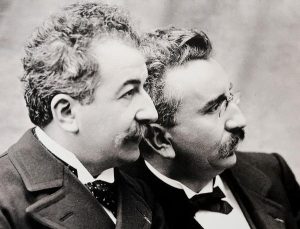
Film History actually goes back to the 1830s, as various European inventors worked on creating spinning disks with images inside them that, when spun, produced the illustion of action. Thomas Edison demonstrated his “peepshow’ Kinetoscope in 1891, a machine that, essentially, worked like a flip-book. A single viewer would peer through the viewer at the top and a reel of special film would be run through the machine to show an image. But though the Kinetoscope was the model of the modern film projectors, it was limited at the time because only one person could use it at a time. Two of the people who saw the machine when Edison brought it to Europe were Auguste Marie Louis Nicolas and Louis Jean Lumiere, who worked in their family’s photographic plate factory in Lyon, France.
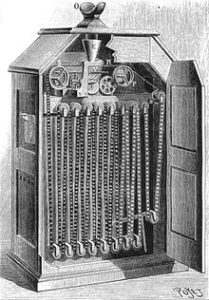
When their father saw the Kinetoscope in 1894, he declared (as many proud parents have throughout history, I’m sure) that his sons could do better. And so, they did. By 1895, they had developed the Cinematographe, a machine that was considerably lighter than Edison’s ponderously heavy projector, used a good deal less film to project an image, and was capable of displaying images on a screen, thus enabling groups of people to watch the same film projection at the same time. Though other inventors had shown ‘moving pictures’ to an audience before, their designs were clunky and immediately supplanted by the remarkable Cinematographe.
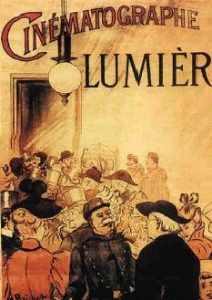 The Lumiere Brothers debuted their invention at the Salon Indien du Grand Café in Paris on December 28, 1895. In an evening of technological and cinematographic history, they screen ten films, each less than a minute long (each film was approximately 17 meters long). The program consisted of films shot in and around Paris by the brothers themselves, though it is thought that they used Léon Bouly‘s cinématographe device, which was patented the previous year (just to show you how much inventors were focused on moving pictures at this point). The order of the films screened were as follows (you can read more about each film in the link in the titles):
The Lumiere Brothers debuted their invention at the Salon Indien du Grand Café in Paris on December 28, 1895. In an evening of technological and cinematographic history, they screen ten films, each less than a minute long (each film was approximately 17 meters long). The program consisted of films shot in and around Paris by the brothers themselves, though it is thought that they used Léon Bouly‘s cinématographe device, which was patented the previous year (just to show you how much inventors were focused on moving pictures at this point). The order of the films screened were as follows (you can read more about each film in the link in the titles):
- La Sortie de l’Usine Lumière à Lyon (literally, “the exit from the Lumière factory in Lyon”, or, under its more common English title, Workers Leaving the Lumiere Factory), 46 seconds
- Le Jardinier (l’Arroseur Arrosé) (“The Gardener”, or “The Sprinkler Sprinkled”), 49 seconds
- Le Débarquement du Congrès de Photographie à Lyon (“the disembarkment of the Congress of Photographers in Lyon”), 48 seconds
- La Voltige (“Horse Trick Riders”), 46 seconds
- La Pêche aux poissons rouges (“fishing for goldfish”), 42 seconds
- Les Forgerons (“Blacksmiths”), 49 seconds
- Repas de bébé (“Baby’s Breakfast” (lit. “baby’s meal”)), 41 seconds
- Le Saut à la couverture (“Jumping Onto the Blanket”), 41 seconds
- La Places des Cordeliers à Lyon (“Cordeliers Square in Lyon”—a street scene), 44 seconds
- La Mer (Baignade en mer) (“the sea [bathing in the sea]”), 38 seconds
These films are also hailed as the first primitive documentaries, since they show real people going about their real lives–particularly the workers exiting the Lumiere factory–as well as the first comedies, since “The Gardener” is an early form of slapstick comedy.
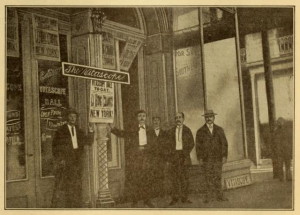 The effect their invention had on popular culture was immediate and enormous. People flocked to see screenings across Europe as the Lumieres took their invention on tour. The Lumieres opened theaters (which they called cinemas) in 1896 to show their work and sent crews of cameramen around the world to screen films and shoot new material. New Orleans’ Vitascope Hall–the first cinema in the United States–opened that same year (admission was 10 cents), and The New York Times published its first film review in 1909. However, neither brother believed that ‘cinema’ had a future, and decline to sell their camera or disseminate their technology, which didn’t earn them many friends. Though they would go on to develop new kinds of photographic color plates that revolutionized photography, their involvement in film history was quite brief…but no less important for that.
The effect their invention had on popular culture was immediate and enormous. People flocked to see screenings across Europe as the Lumieres took their invention on tour. The Lumieres opened theaters (which they called cinemas) in 1896 to show their work and sent crews of cameramen around the world to screen films and shoot new material. New Orleans’ Vitascope Hall–the first cinema in the United States–opened that same year (admission was 10 cents), and The New York Times published its first film review in 1909. However, neither brother believed that ‘cinema’ had a future, and decline to sell their camera or disseminate their technology, which didn’t earn them many friends. Though they would go on to develop new kinds of photographic color plates that revolutionized photography, their involvement in film history was quite brief…but no less important for that. 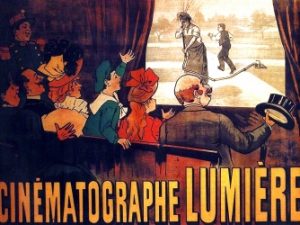
So why not come into the Library today and check out some of our impressive DVD collection in honor of the Lumiere brothers? Or, at the very least, to prove to them how remarkable their invention truly was?
